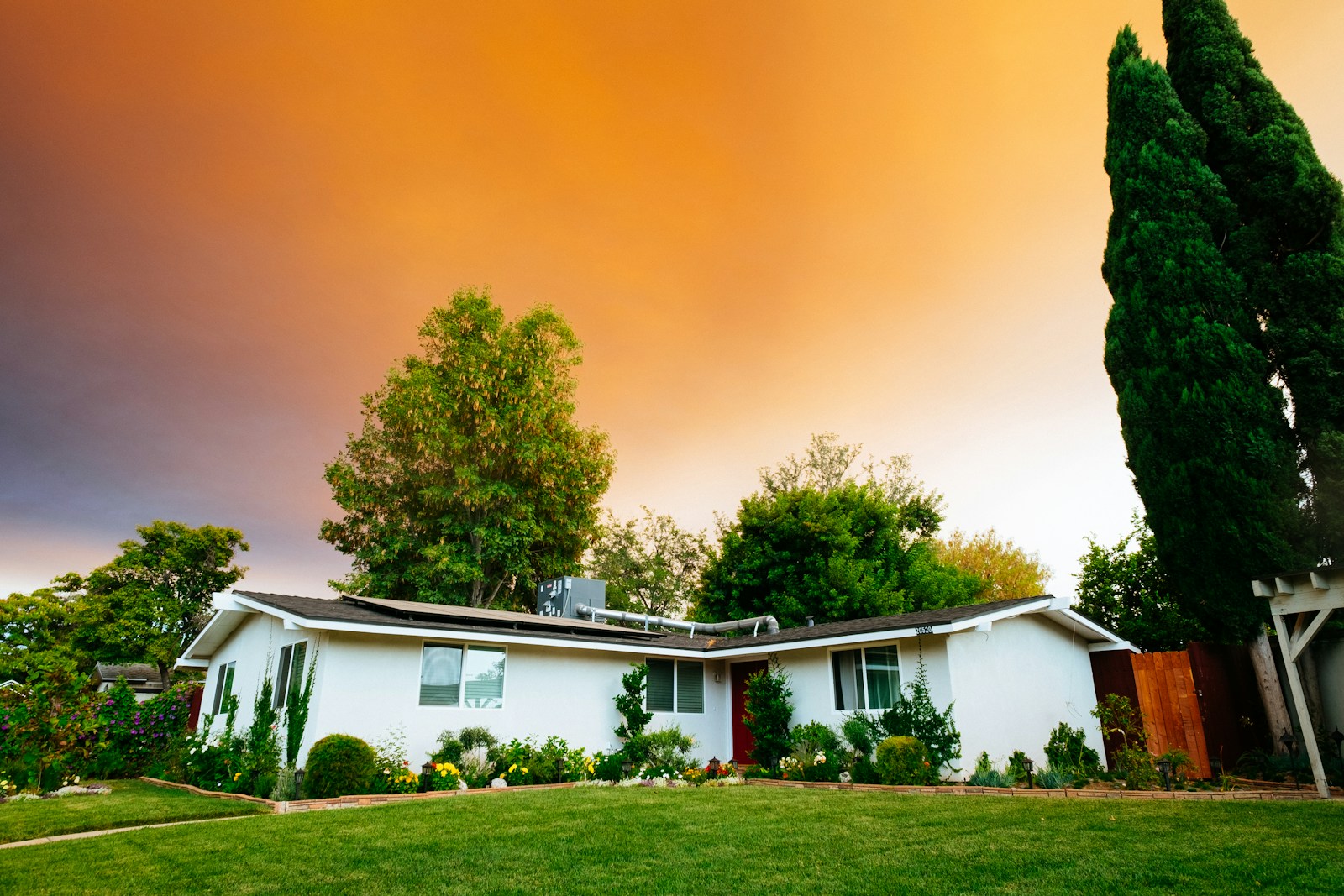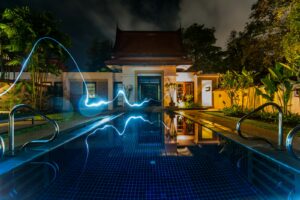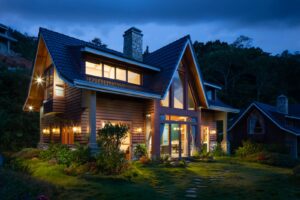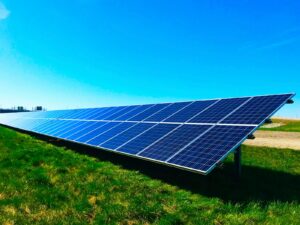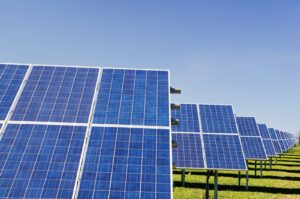Imagine transforming your house into a comfortable fortification of energy efficiency where appliances labour while you relax with a cold drink.
Being an energy-efficient smart homeowner is not only trendy but also a smart approach to live well and save your hard-earned money in a time when our houses can almost think for themselves.
Did you know that just changing those outdated energy hogs could save you roughly $500 annually on utilities? Alternatively you could cut your consumption by a wild 10-50% by using energy-efficient tools.
Let us get right to work on turning your house into a green paradise.
First of all, smart thermostats learning your habits—that of your dog—know when dinner time arrives.
They will keep your house comfortable and cut those energy expenses.
Combine that with Energy Star appliances, the small label that could—because they sip energy like a fine wine, not guzzle it like a frat boy at a keg party.
Remember also sprucing that insulation to maintain locked in warmth.
Your friendly guide on creating this energy-efficient kingdom is here:
- Get yourself smart lights, energy monitors, and thermostats that are wise for your budget. Watching your energy use is simple thanks to these little assistants. For example, change to LED lights to save up to 80% of the energy. More money for the fun stuff!
- Embrace Smart Appliances: Flexible and effective modern washers, dryers, and refrigerators are like the yoga teachers of the appliance world. Take the Samsung Smart Front Load Washers. It consumes twenty percent less energy and thirty percent less water than cranky old models. Your utilities will thank you for the break.
- Install smart sensors on your heating and cooling systems to help them to tune themselves. They will know when people are around and modify the temperature to save roughly 15% annually. Right there is money in the piggy bank.
- Install systems like the Rachio Smart Sprinkler Controller to modify your watering schedule depending on the temperature. You might cut your outside water consumption by half. Really, Mother Earth will thank you and your garden will as well.
- Harness Renewable Energy: Like the SunPower Equinox System, delve into the sunny side using solar panels. Over 25 years, it should save you up to $30,000. You will also feel like an eco-warrior engaged in the right fight.
Keep these golden rules close as you start down the path of creating your energy-efficient smart home: cut energy use, welcome handy technology, and routinely check your systems.
Your regular living area can become a shining example of sustainability with the correct devices and some elbow effort.
This is the future calling, not only a pipe dream; it is also highly within your reach.
Understanding Smart Home Energy Efficiency
Energy efficiency is the measure of a home’s energy consumption for operation.
Advanced technology used in an energy-efficient smart home helps to maximise energy usage while preserving comfort and utility.
Smart technology’s marriage with energy efficiency lets homeowners lower their environmental impact without compromising modern conveniences.
Including smart devices will help you to really understand how you use energy.
These devices offer data that can guide wise energy consumption decisions, so promoting cost savings and a better environment.
Knowing energy efficiency redefines our way of life rather than only helps us to lower bills.
Every device in your house contributes to its energy consumption.
This knowledge helps one to adopt energy-saving techniques.
Energy efficiency basically seeks to minimise energy waste and offer the same degree of comfort.
The secret is to welcome technology that lets homeowners properly monitor and regulate their energy consumption.
What is efficiency in energy?
Energy efficiency is the use of less energy to render the same benefit.
In the framework of a smart home, it entails applying technologies and techniques meant to lower energy waste.
Energy efficiency can vary from installing smart devices tracking real-time consumption to modernising appliances. Here are some more specific breakdowns of it:
- By learning your schedule and preferences, smart thermostats maximise heating and cooling systems, so saving energy.
- Energy-efficient appliances—those bearing the Energy Star label—use less energy than conventional models.
- Insulation and Sealing: Well insulated homes cut heating and cooling demand.
Many data show the need of energy economy. Based on the United States’
Energy-efficient appliances from the Department of Energy could cut consumption between 10 and 50%. Moreover, ineffective systems waste reportedly thirty percent of the energy consumed for heating and cooling in homes.
Advantages of an Energy-Effective House
Making investments in energy efficiency pays off in many ways. Here is a comprehensive view:
- One main advantage of energy-efficient homes is reduced utility costs. The American Council for an Energy-Efficient Economy ACEEE estimates that average annual savings from energy-efficient improvements could be $500 for homeowners.
- Energy-efficient homes preserve a more constant temperature, so improving comfort. This is especially true in systems for heating and cooling that are routinely maintained and maximised.
- Energy-efficient homes help to reduce pollution by consuming less of the energy overall. Reducing the carbon footprint advances sustainability as well as helps to slow down climate change.
- Resale value of homes with energy-efficient improvements usually is higher. According to a National Association of Realtors study, 16% more sale price can be earned from energy-efficient homes.
- Health Benefits: Energy-efficient homes’ better air quality helps their occupants’ health. Good ventilation and less moisture help to prevent mould, so lowering respiratory problems.
All told, the several benefits of energy efficiency help to raise living standards.
Fundamental ideas in energy conservation
Energy-efficient smart homes are created in great part by several fundamental ideas that underlie energy-conservation. Following are some fundamental ideas:
- Minimising energy consumption by better use patterns is the main objective. This covers thoughtful device operation and energy-efficient appliance use.
- Behavioural Changes: Little behavioural changes can result in significant energy saving. Energy costs can be greatly lowered by turning off lights when leaving a room, unplugging appliances not in use, and using natural light rather than artificial one.
- Including renewable energy sources into your energy plan, when practical, will help to improve energy economy. Using solar energy helps one lessen reliance on more conventional energy sources.
- Planned maintenance for appliances and HVAC systems helps to avoid inefficiencies by means of scheduling. Well kept machinery runs better and uses less energy.
- Automating controls by means of smart devices helps to maximise energy consumption. Timed heating and cooling, automated lighting, and energy monitoring all help to save overall.
| Principle | Description |
|---|---|
| Reduce Energy Use | Minimizing consumption through smarter habits |
| Behavioral Changes | Adjusting daily routines for energy savings |
| Renewable Energy Utilization | Exploring solar and other renewable sources |
| Regular Maintenance | Ensuring systems are efficiently running |
| Smart Tech Integration | Automating controls for optimal energy use |
These ideas provide a structure for homes trying to improve energy efficiency by deliberate effort and creative technologies.
Essential Tools for Energy Control
Energy management technologies have become absolutely essential as homes change into smarter places.
These basic devices let homeowners efficiently monitor and regulate energy usage.
Smart technology’s combined with energy management produces more informed consumption and improved general efficiency.
They give you control and awareness as well as real-time data to help you monitor your energy use.
The core of energy economy in contemporary homes is smart devices.
An efficient energy management plan is built from many devices ranging from smart thermostats to energy monitoring systems, which results in major long-term savings.
Nest Learning Thermostat: Smart Thermostat
Its capacity to learn the homeowner’s schedule and preferences and modify heating and cooling based on that distinguishes it. These are some salient characteristics:
- The thermostat learns your routines over the first few weeks of use and automatically adjusts to offer the ideal temperature as needed.
- By means of its app, you may remotely control your thermostat from anywhere, so enabling on-the-go adjustments for best energy savings.
- Nest offers monthly energy reports that reveal your usage and ideas for energy saving.
- Integration: It enhances general home automation by smoothly interacting with other smart devices including home security systems and smart lighting.
According to Google, using the Nest Learning Thermostat can save an average of 10–12% on heating bills and 15% on cooling ones yearly.
Systems of Monitoring Energy: Sense Energy Monitor
The Sense Energy Monitor is yet another indispensable tool for energy control.
This gadget offers real-time views of the energy consumption in your house. This is what it offers:
- The Sense monitor tracks energy usage down to the appliance level, so determining which devices consume the most power.
- Notifications and alerts regarding unusual energy consumption help to early identify possible problems or inefficiencies.
- Analyse usage trends in daily energy reports to guide informed changes in energy consumption.
- Create energy targets and track development to make sure you keep conscious of consumption.
Homes using energy monitoring systems can cut energy consumption by up to 15%, thus this is a desirable choice for smart energy management according to statistics.
TP-Link Kasa Smart Wi-Fi Power Strip—Smart Power Strips
Although they are sometimes disregarded, power strips can significantly help to save energy.
There are several sophisticated capabilities in the TP-Link Kasa Smart Wi-Fi Power Strip:
- Using the Kasa app, remotely manage linked devices to guarantee that energy is not wasted on idle ones.
- Voice Control: Designed for hands-free operation in line with Alexa and Google Assistant.
- Timers for devices to turn off help to guarantee they are not left on unnecessarily.
- Track energy consumption for every gadget hooked to the strip to help determine which might need replacement with more energy-efficient choices.
By up to 25%, smart power strips help to lower phantom loads—that is, the energy consumed by standby-activated devices—so providing notable energy savings.
Modern Lighting Solutions
Regarding energy economy, lighting is a basic concern.
While preserving appearance in your house, smart lighting solutions not only offer convenience but also help to reduce energy costs.
Advances in intelligent systems and LED technology allow homeowners to enjoy lighting that fits their schedules and needs.
One of the easiest things anyone can do towards an energy-efficient house is change to smart lighting solutions.
These contemporary systems can drastically cut energy consumption, so promoting a more ecologically friendly way of life.
Many top brands and products offer a range of clever lighting choices, so providing creative answers for different purposes.
Philips Hue White and Colour Ambiance: LED Bulbs
Versatility and colour choices of Philips Hue LED bulbs are well-known.
Any smart lighting system needs them absolutely. The main characteristics consist in:
- Philips Hue bulbs use up to 80% less energy than conventional incandescent bulbs, so saving a normal household up to $200 annually.
- With more than 16 million colours, these bulbs can create the ambiance for any occasion and help to lower the demand for extra ornamental lighting.
- Using your smartphone or a smart assistant, control your lights from anywhere.
- Program your lights to turn on or off at designated times to help to reduce unneeded energy consumption.
These LED lights improve visual appeal and help to significantly lower energy consumption when included into your lighting schedule.
Lutron Caseta Wireless Smart Lights
Control of bigger areas with several light sources depends on smart light switches.
Features of the Lutron Caseta Wireless switch make it a rather common choice:
- For hands-free operation, quickly connect smart switches with Alexa, Google Assistant, or Apple HomeKit.
- Lighting scenes for different events will help you to create the ideal atmosphere and schedule lights around your daily life.
- Control lights in your house to provide security even while you’re away.
- Smart switches can save up to 20% yearly on lighting costs when replacing conventional switches.
Smart light switches let homeowners easily control their energy use all around the house.
The Philips Hue Motion Sensor
Motion sensors guarantee that lights are on only when necessary, so improving smart lighting systems.
Among several benefits is the Philips Hue Motion Sensor’s:
- Lights turn on automatically when motion is sensed, thus you never enter a dark room.
- This sensor can be set to only turn on lights when it is dark outside, so reducing daily energy consumption.
- Tailor the sensitivity and activation periods depending on your household need.
- Motion sensors discourage possible intruders by themselves when combined with lighting systems.
Motion sensors are a wise investment in any energy-efficient smart home since, when used well, they can drastically cut energy costs by reducing unneeded lighting.
Clever Devices Saving Energy
Combining sophisticated technology with user-friendly interfaces, smart appliances mark a major breakthrough in energy efficiency.
These appliances help homeowners to keep good performance while using less energy.
Not only does investing in energy-efficient appliances help the environment, but utility bill savings are guaranteed.
Making wise decisions depends on knowing how certain appliances help to save energy.
Among the several features of energy-efficient models meant to lower consumption are smart sensors and performance diagnostics.
Homeowners can significantly increase their general efficiency by looking at particular items that show energy-saving qualities.
Whirlpool WRB322DMBM: Energy-efficient refrigerator
Leading example of energy-efficient refrigeration technology is Whirlpool WRB322DMBM. Important traits consist in:
- Energy Star Certified models help to reduce energy costs by consuming less than non-certified models.
- Unlike fixed-cycle competitors, adaptive defrost saves energy by running the defrost cycle just when needed.
- LED Lighting: Using less energy and better visibility, LED lights brighten the inside more effectively than standard refrigerator bulbs.
- Effective organisation helps maximise space and minimise energy usage, so optimising energy management.
Features like these help the Whirlpool WRB322DMBM to save an average of $100 annually in energy costs when compared to more outdated models.
Samsung Smart Front Load Washers—Smart Washers and Dryers
The Samsung Smart Front Load Washers show how contemporary technology can save laundry’s energy consumption. This is how:
- Comparatively to conventional models, the washer runs 30% less water and 20% less energy per load.
- Remotely controlling and observing the cycle of the washers will help you to maximise water and energy use based on your need.
- Eco Mode: While preserving performance, this feature modifies temperature and wash times to reduce energy usage.
- Load Sensor: Automatically determines load size and modulates energy and water levels in line.
Users of energy-efficient washers typically save about $40 yearly, thus the Samsung model appeals to those trying to save.
Modern Ovens: June Oven
An advanced cooking tool with clever technology to improve energy economy is the June Oven. Its characteristics consist in:
- Artificial intelligence enables the oven to identify food and suggest cooking times and temperatures, so preventing overcooking and energy waste.
- Quick meal starting is made easier by fast preheat, which heats faster than conventional ovens.
- The June app lets you monitor and change cooking remotely, so ensuring you’re not wasting too much energy waiting.
- Energy Star Certified: The oven guarantees less power consumption than conventional ovens by satisfying rigorous energy efficiency criteria.
Using these characteristics will help homeowners simplify cooking tasks and cut energy costs, so creating a functional kitchen.
Systems of Home Automation
Through their integration of several smart devices into a coherent network, home automation systems greatly improve energy efficiency.
This technology lets householders easily control their energy consumption.
Automation lets you design routines, schedule appliances, and get notifications, so helping you to keep a home with low energy consumption.
Since it affects how well devices interact and run together, selecting the correct automation system is absolutely vital.
Knowing the features and advantages of the several hubs and systems available helps consumers to choose the best one for their particular needs.
Selecting a Hub: Samsung SmartThings
Both new and experienced smart home enthusiasts will find Samsung SmartThings to be a flexible hub that can link a great range of gadgets. Here’s the reason it distinguishes:
- Works with thousands of devices from many manufacturers to guarantee wide use choices.
- Ease of Setup: Quick integration made possible by the app-guided installation gives every user, regardless of tech-savvy degree access.
- Set routines and automation for best energy management, including shutting off lights upon everyone leaving the house.
- Away from home, monitor and change settings for every connected device using a single app.
SmartThings improves energy management by giving you complete control over your smart devices, so enabling good energy monitoring.
Combining Devices for flawless control
The success of a home automation system depends on the harmony among the devices.
Integrating devices is connecting them via the hub such that they may be controlled from one interface. :
These pointers help to guarantee a flawless integration:
- Make sure devices you want buy fit your selected hub before you buy them. Make sure selected appliances and devices can be combined without conflict.
- Create a central command on your smartphone or voice-activated assistants to simplify navigation through automatically configured settings.
- Logical grouping of related devices will help to efficiently control them. From a single command, you might wish to control all outdoor lights and security devices.
- Using smart sensors, design clever automation systems including motion sensors controlling hallway lighting depending on movement.
Integrated devices help to streamline and properly monitor energy consumption, so enabling large savings.
Automated Programming for Energy Saving
By guaranteeing devices run at ideal times, automated schedules and routines help to maximise energy economy.
Programming automation tells your smart devices when to run, so greatly affecting energy consumption. These are effective tactics:
- Set your smart thermostat to change the temperature for both when you wake and sleep as well as for when you are away. Your annual energy bill may save 10 to 30 percent by doing this.
- Automate indoor and outdoor lights depending on occupancy or particular times to turn on and off.
- Program energy-efficient appliances to run during off-peak hours when energy is often less costly.
- Review your routines and schedules often to maximise energy savings as your seasons or way of life alter.
Effective programming techniques help to achieve significant savings, so improving the cost-effective and environmentally friendly living surroundings.
Eco-friendly Energy Sources
Energy efficiency depends much on sustainability, which also guides homeowners towards more environmentally friendly solutions.
Adopting sustainable energy sources not only helps to cut environmental damage but also helps to lower energy costs.
Sustainable solutions like solar panels and energy storage systems let for more major autonomy and efficiency in the era of technology.
Purchasing sustainable energy technologies not only helps homeowners but also provides a good model for community preservation.
Every sustainable choice helps to propel a greater movement towards lower environmental impact and increased energy independence.
Equinox System Solar Panels: SunPower
Modern solar technology and its possible for energy savings are best shown by the SunPower Equinox System:
- High Efficiency: SunPower panels produce up to 70% more energy in the same area over 25 years than conventional panels, averaging above 22%.
- Integrated design guarantees simplified aesthetics, so reducing installation costs and optimising available space.
- This system tracks and controls energy output, so enabling more informed choices on energy consumption.
- Designed to resist severe conditions, the panels have a 25-year warranty, so proving their dependability.
Over 25 years, investing in solar technology can result in savings of up to $30,000 while simultaneously encouraging the usage of renewable energy.
Energy Storage Devices: Tesla Powerwall
Leading home energy storage system is the Tesla Powerwall.
This creative solution maximally uses produced renewable energy by letting homeowners save energy for use later on. Important characteristics consist in:
- The 13.5 kWh Powerwall is fit for use during outages or peak energy consumption since it stores.
- Powerwall connects with solar systems to maximise energy use, so ensuring you first make use of self-generated energy.
- Homeowners can link several Powerwalls to provide more capacity, so allowing bigger houses and families.
- An app lets users monitor energy generation and consumption, so guaranteeing a knowledge of energy flow.
By maximising their energy use, homeowners can cut as much as 60% on their electricity costs by means of sensible storage techniques.
SolarEdge Optimiser: Smart Inverters
Smart inverters improve solar system energy consumption efficiency by means of the SolarEdge Optimiser. This is how:
- Regardless of panel orientation or shading, the optimiser maximises the total energy collected from solar panels at any one moment.
- Monitoring capabilities let one proactively maintain each panel by offering real-time performance data.
- Built-in safety measures included in SolarEdge optimisers help to reduce the hazards connected to energy production.
- By up to 25%, smart inverters can boost energy generation, so optimising the performance of your solar system.
Selecting appropriate sustainable energy solutions, such smart inverters and solar panels, will help to drive significant cost savings and encourage environmental responsibility.
Improving HVAC Energy Consumption
Usually the biggest energy users in a house are heating, ventilation, and air conditioning systems.
Consequently, maximising HVAC efficiency can significantly affect general energy costs.
Combining smart devices with proper maintenance will help to guarantee that these systems run at their best.
Optimising HVAC systems improves indoor comfort in addition to helping to lower utility costs.
Understanding how various technologies and systems interact helps homeowners create an energy-efficient and comfortable year-round surroundings.
Ecobee SmartSensors: Intelligent HVAC Sensors
Ecobee SmartSensors are among smart sensors that enable HVAC system optimisation. Their advantages include:
- These sensors identify temperature changes in various rooms, so enabling more intelligent heating and cooling changes.
- They track occupied rooms and modify settings for energy savings when a room is empty.
- Integration: Perfectly matches Ecobee thermostats to guarantee energy economy all around your house.
- Homeowners can remotely monitor and change settings using a handy app.
By making sure heating and cooling are only used when necessary, Ecobee SmartSensors can result in yearly savings of roughly 15%.
Zoning Systems to Maximise Airflow
Zoning systems separate the house into several sections with individual heating or cooling capacity. This tactic improves effectiveness:
- Customised Climate Control: Occupancy, preferences, and need will all affect the temperature each zone can be set to.
- Homeowners can save a lot of energy by not heating or cooling unneeded spaces.
- Many modern zoning systems complement smart thermostats and sensors to maximise efficiency.
By improving comfort and lowering total HVAC load, a zoning system can help to save up to thirty percent.
Frequent Maintenance and Monitoring Strategies
Frequent HVAC system inspections help to avoid inefficiencies aggravating energy costs. Review the following maintenance strategies:
- Every one to three months, routinely replace or clean filters to let systems run more efficiently and enable better airflow.
- Plan yearly inspections or cleanings for every HVAC system to guarantee best operation.
- Check ductwork for leaks or blockages to cause up to thirty percent of energy losses.
- Review whether your current HVAC system satisfies modern efficiencies and, if needed, think about improvements.
Regular maintenance helps to greatly extend system lifetime and efficiency, so saving homeowners large amounts on their energy bills.
Water Saving Instruments
Strategies for energy efficiency in homes naturally include water conservation.
Smart water management systems let homeowners track and cut water consumption, so saving energy in the end.
By means of creative technologies in irrigation and leak detection, effective water use can be facilitated, so guaranteeing sustainability in household management.
Including water-saving technologies into your house will help to lower energy use generally.
Knowing water conservation techniques and tools in great detail will enable homeowners to adopt better lifestyle choices and practise financial responsibility.
Rachio Smart Sprinkler Controller—Smart Irrigation Systems
An intelligent way to effectively control outdoor irrigation is with a Rachio Smart Sprinkler Controller. Included are:
- Automatically changing watering plans depending on local weather forecasts helps to prevent overwatering.
- Users of remote management apps can change schedules from anywhere, so guaranteeing best water use.
- Control several areas in your garden to offer tailored irrigation based on the requirements of different plant species.
Smart irrigation systems offer significant financial and environmental advantages as well as help homeowners save almost half of their outdoor water consumption.
Lyric Wi-Fi Water Leak Detector from Honeywell
Water leaks can cause major water waste as well as later rises in energy prices.
The Honeywell Lyric Wi-Fi Water Leak Detector helps stop this:
- Notifies homeowners right away upon leaks, so minimising possible water damage and waste.
- Track ambient temperature and humidity levels to notify users should conditions cause freezing pipes.
- Simple Setup: Easy installation in usually simple, low-complex home surroundings.
By means of leak detection, a proactive approach could possibly save up to 2,000 gallons of water per leak, so encouraging better water conservation.
Low-flow fixtures: Moen WaterSense faucets
Low-flow fixtures like those from Moen’s WaterSense line drastically cut water use. Some main benefits are:
- Water Conservation: Without compromising performance, low-flow faucets can use up to 30% less water than standard models.
- Reducing water use helps homeowners save monthly on their water bills.
- Most low-flow fixtures are meant for easy installation, thus they are easily accessible for do-it-yourself projects.
Turning to low-flow fixtures can result in an average water savings of up to 700 gallons annually per fixture.
Advice for Maximising Energy Efficiency
Maximising energy efficiency calls for constant monitoring, modification, and maintenance of many facets of your house.
Knowing the several solutions and technologies at hand helps homeowners decide how best to cut their environmental impact and resource use.
Using smart energy practices might help to save money and improve living conditions.
Accessibility to audits and consumption tracking lets homeowners make wise decisions improving their way of life.
Completing an Energy Audit
Understanding and knowing how to increase energy efficiency starts with an energy audit. Usually the audit process consists in:
- Examining their utility bills, homeowners search for odd spikes in energy use.
- Professional auditors evaluate windows, doors, HVAC systems, insulation, and appliances to find places of energy loss in homes.
- Once completed, auditors will produce a report noting modifications that might result in notable energy savings.
Based on American
Energy audits conducted by the Department of Energy can help to find possible savings of 5–30% depending on the results, so justifying their expenditure.
Configuring Consumption Monitoring
Tracking energy use helps homeowners better grasp their consumption trends. Good tracking could consist in:
- Install smart meters to give homeowners real-time data on energy consumption, so enabling better habit modification.
- Many energy companies offer apps that track usage, examine trends, and straightly report anomalies to the user.
- Use thorough consumption reports to link particular activities with usage patterns, so fostering more deliberate energy practices.
Through increased awareness, using consumption tracking tools can result in general energy cost savings of about 15%.
Seasonal Adaptations for Controlling Temperature
Management of energy efficiency depends much on seasonal temperature control.
Making changes depending on the seasons can result in rather large savings:
- Set your thermostat to lower temperatures while you are away or asleep in winter. A smart thermostat can change as needed.
- Use shades or blinds during hottest sun to keep homes cool without running air conditioning systems too much.
- Between heating and cooling, make sure to check filters and change settings for best efficiency.
By ensuring systems are operating effectively in line with seasonal needs, deliberately changing temperature controls can result in energy savings of 10–30%.
Smart Home Energy Efficiency: The Future
Emerging new technologies and trends suggest to make homes even more energy-efficient and clever.
Homesowners have hitherto unheard-of chances to maximise savings while living sustainably as innovation drives change.
Looking ahead, homeowners will find it absolutely vital to grasp new technologies and how they fit into daily life.
Knowing changes and innovations helps families to adapt and flourish in a world going progressively environmentally conscious.
Future Technologies to Observe
Some fascinating technologies just waiting to improve smart home energy efficiency include:
- Improved energy distribution made possible by smart grids helps to maximise use by preventing outages.
- Blockchain for Energy Transactions: This technology enables consumers to buy and sell energy depending on real-time usage, so supporting peer-to–peer energy trading.
- Electric cars will eventually become energy sources, enabling homeowners to run their houses during outages from drawing on their vehicles.
Keeping ahead of energy management techniques and using fresh ideas for efficiency depends on homeowners tracking these developing technologies.
AI’s Place in Energy Management
Smart homes’ energy management is being revolutionised by artificial intelligence. The influence covers:
- Predictive analytics—that is, artificial intelligence—can forecast trends in energy consumption depending on usage patterns, so suggesting changes for best savings.
- By means of artificial intelligence, home systems can learn user preferences and automate energy modifications to maximise comfort and economy.
- By examining performance data from systems and appliances, artificial intelligence algorithms can identify possible problems before they cause ineffective energy consumption.
Reduced energy costs and improved home comfort resulting from AI-driven technologies help to shape a more sustainable future by greatly lowering their impact.
Developments in Ecological Living
The movement towards energy-efficient homes fits more general patterns in sustainable living. Important developments include:
- Minimalism and Functional Living: Homeowners are selecting smaller, more energy-efficient houses that call for less upkeep.
- Emphasising environmentally friendly materials and sustainable building products and tools will help to further lower environmental impact during construction.
- Community solar programs let several homes gain from a shared solar energy system, so improving access to renewable sources.
Homeowners who follow these trends will be in line with an expanding movement that gives environmental preservation and energy economy top priority, so fostering a better planet for next generations.
Notes of Final Thought
Ultimately, adopting the path towards a smart home with energy efficiency is not only a trend but also a necessary action towards a sustainable future.
Modern technologies combined with daily living turn houses into efficient ecosystems.
By cleverly using smart devices—from thermostats to appliances—energy consumption can be greatly lowered, so relieving finances along with environmental responsibility.
For homes ready to act, the possibility to save up to 50% on energy costs by using energy-efficient models and techniques presents a strong motivation.
The benefits go beyond only slight utility bill savings.
Improved air quality, more comfort, and higher property values point to the several advantages of using energy-efficient systems.
Studies from top companies in the sector show that, with energy-efficient improvements, homeowners can save an average of $500 yearly while year-round enjoying warmer, cosier surroundings.
Given inefficiencies in homes wasting more than thirty percent of their energy, there is obviously room for improvement.
Effective energy management is based on consistency in energy use monitoring and turning that data into practical insights.
Smart technology helps homeowners to make decisions as well as to see usage patterns.
Families can remain alert in their energy battles by doing frequent energy audits and establishing consumption tracking, so grabbing chances for further savings and conscious use.
Looking forward, the combination of energy economy and technology will change still more.
Innovations like smart grids and AI-driven energy management on the horizon inspire homeowners to keep educated and ready to welcome new ideas that would maximise their living surroundings.
Sustainable practices and simplified systems not only open the path for individual savings but also set a standard for sensible energy use in localities.
By building energy-efficient smart homes together, we enable generations to come as well as ourselves to help to create a cleaner, healthier earth.
Frequently Asked Questions
What main objective does energy efficiency in homes serve?
Energy efficiency in homes mostly serves to reduce energy consumption while preserving the same degree of comfort and utility.
This calls for applying cutting-edge technologies and methods meant to lower energy waste.
With an energy-efficient smart house, how might I cut expenses?
Investing in appliances and energy-efficient devices will help to reduce your utilities.
By making energy-efficient improvements, homeowners often save about $500 a year, so improving environmental sustainability as well as financial viability.
Could I make any quick fixes to improve the energy efficiency of my house?
True! Energy use can be drastically cut with simple adjustments including switching to LED lighting, using smart thermostats, and window sealing.
Savings can result from even little behavioural changes like shutting off lights when not in use.
What are smart thermostats, and how do they operate?
Like the Nest Learning Thermostat, smart thermostats learn your schedule and preferences, then automatically modify heating and cooling to maximise energy use.
Annually, they can save 15% on cooling costs and 10 to 12% on heating.
In what ways might smart appliances help to save energy?
Using sophisticated technology, smart appliances maximise performance and lower energy consumption.
Energy-efficient dryers and washers, for instance, change cycles depending on load size to guarantee low energy use without compromising cleaning performance.
In an energy-efficient house, what part might solar panels play?
By allowing homes to create their own energy, solar panels—like the SunPower Equinox System—help to greatly lower dependence on conventional energy sources.
Over 25 years, they can result in savings ranging from $30,000.
Is it possible to track my energy consumption right now?
Indeed, you can real-time track the energy consumption of your house using energy monitoring systems such as the Sense Energy Monitor.
This awareness helps you to decide how much energy you use, so enabling possible 15% savings.
How would I go about doing an energy audit for my house?
Usually involving a review of your house for energy use patterns, an energy audit finds inefficiencies and generates ideas for improvement.
For a comprehensive study, either you could do one yourself or pay a professional.
Low-flow fixtures are what? And how might they benefit?
Like Moen WaterSense faucets, low-flow fixtures drastically cut water use—up to 30% less than conventional fixtures—which lowers water bills and associated energy use related to water heating.
Is there any way I might efficiently automate my energy consumption?
Indeed, configuring smart home automation systems lets you schedule appliances, track energy consumption, and design routines maximising energy use.
This can improve conveniency and result in notable savings.

